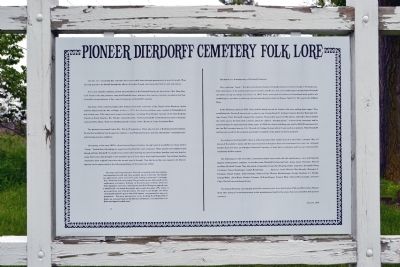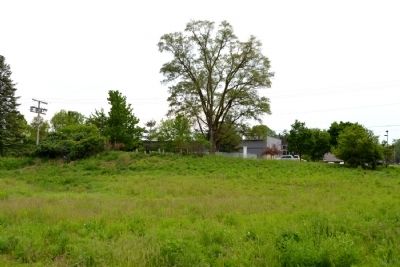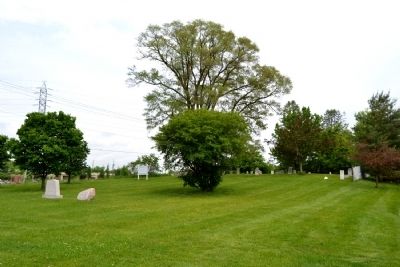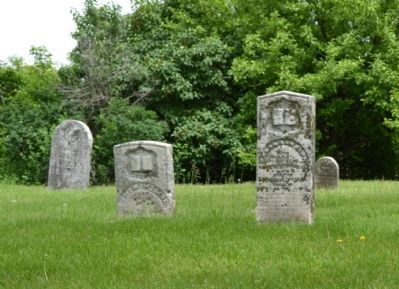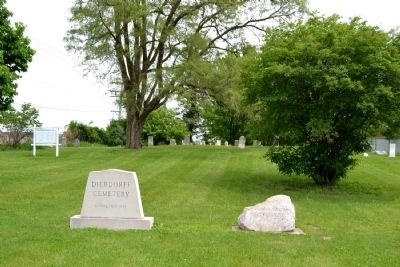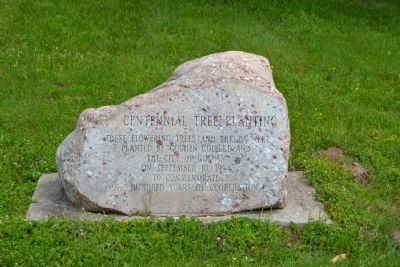Goshen in Elkhart County, Indiana — The American Midwest (Great Lakes)
Pioneer Dierdorff Cemetery Folk Lore
The folk lore concerning this cemetery has been handed down through generations by word of mouth. Most of it has proved to be factual through the efforts of Gordon Treesh, who researched old records and diaries.
This is not a family cemetery, all but nine members of the Dierdorff family are buried here. Mrs. mary Dierdorff Treesh is the last person to carry the Dierdorff name; and since the cemetery has been located on her family land for six generations, it has come to be known as Dierdorff Cemetery.
The story of this cemetery began when Anthony Dierdorff, a minister of the Church of the Brethren, sailed with his family from the Isle of Wright, in June of 1719. He, his wife and three sons, landed in Philadelphia in July of that year. With them were twenty-nine families, including Peter Becker, founder of the first Brethren Church in North America. Rev. Becker, assisted by Rev. Anthony Dierdorff, established churches in Pennsylvania and New Jersey. There is a building named in honor of Rev. Becker at Camp Alexander Mack.
Two generations passed before Rev. Dierdorff's grandson, Peter also became a Brethren preacher-farmer. He and his forefathers had always been farmers in the Philadelphia area; and they shared their "meeting house" with German Baptist neighbors.
One spring, in the early 1830's, three German Baptist families, having heard of wonderful but cheap land in "Ioway," loaded their belongings on wagons and headed their oxen westward. These people were neighbors and friends of Peter Dierdorff. It would be two years before hearing any news from these families; and only then because there was a bad drought in the southern part of Iowa where these families settled. One of these families returned to their original home after the second year of drought. They had more than one reason to be discouraged as can be appreciated in the following glimpse of their personal ordeal.
"Our trip was long and hard. We had no trouble with the Indians, but experienced cold and rainy weather much of the trip. Our daughter, aged seven years, was never well, having contracted "consumption" when she was very young. We got as far as one mile south of the settlement at Goshen, Indiana, in the latter part of June, when our little daughter went into convulsions and died. Being encamped near a small knoll, we asked the settler who owned the land, a Mr. Cripe, if we could buy our little girl there. He said it was alright. So after covering Elizabeth's grave with wild daisies, we prepared to move on westward. We were advised not to try fording the Elkhart River there; so, we went back to the Benton settlement, recrossed the river there and again headed west."
This burial was the beginning of Dierdorff Cemetery.
After reaching "Ioway," the above mentioned family eventually returned to their friends in Pennsylvania. Their description of the prairie land between Goshen and Benton was so favorable and vivid that Peter Dierdorff decided to bring his family to Goshen. In 1853, Peter journeyed to Indiana on horseback with gold in his saddlebags to purchase a wide strip of land extending from the Fort Wayne Trail (U.S. 33) west to the Elkhart River.
In the following spring of 1854, Peter and his family set out for Goshen with oxen pulling their wagon. They established the Dierdorff homestead on what is now County Road 27, halfway between Kercher Road and College Avenue. Peter Dierdorff enlarged the cemetery. He provided space for fifty graves, and built a fence around the entire parcel. He then built a church, which he called a "meeting house," in front of the cemetery; and he preached there for approximately thirty years. In 1893 the church building was sold for $25.00 and moved to the Len McConoughy farm on U.S. 33 south of College Avenue where it was used as a grainery. Peter Dierdorff and his sons cared for the cemetery and made it available to the public for burial purposes.
According to the Dierdorff's there is a Revolutionary War soldier buried in this little cemetery. But, all traces of the soldier's name and the
exact location of his grave have not been known for years. So, although Goshen does not have an Arlington National Cemetery, it does have a cemetery with its own Unknown Revolutionary Soldier's grave.
The following is a list of Goshen community names associated with the maintenance, care and financial support of this pioneer cemetery. It includes many Dierdorff's following Peter. Jonas, Jesse, Theodore, Peter II and Mary Dierdorff Treesh. They had plenty of assistance from the following people, long since deceased: Henry A. Lehman, Fannie Rensberger, Josiah Rensberger, ........ Spencer, Jacob Obrecht, Burt Stouder, Benjamin F. Stutsman, Daniel Ganger, Jesse Hartman, Samuel Cripe, Monroe Schellenberger, George Vaniman, J.I. Kindig, George Miller, John Meyers, Reuben Trimmer, William Bowser, Francis Metz, Charles McConoughy, Emanual Cripe, David Evans and Susan Evans.
The Dierdorff family now happily turns the cemetery over to the Goshen Parks and Recreation Department after using all remaining monies in the maintenance fund for the stone that now identifies this pioneer cemetery.
July 18, 1978
Topics. This historical marker is listed in these topic lists: Cemeteries & Burial Sites • Settlements & Settlers. A significant historical month for this entry is June 1719.
Location. 41° 33.652′ N, 85° 49.679′ W. Marker is in Goshen, Indiana, in Elkhart County. Marker can be reached from the intersection of S. Main Street (State Road 15) and River Vista Drive, on the right when traveling north. Touch for map. Marker is in this post office area: Goshen IN 46526, United States of America. Touch for directions.
Other nearby markers. At least 8 other markers are within 2 miles of this marker, measured as the crow flies. A History of the Winona (about 500 feet away, measured in a direct line); The Goshen Dam and Millrace Hydraulic Canal (approx. 0.4 miles away); Goshen College (approx. half a mile away); The Engines of the Winona (approx. 0.7 miles away); A History of the Winona / Bethany Christian Schools (approx. one mile away); Violett Cemetery (approx. one mile away); Shanklin Park (approx. 1.1 miles away); Waterford Elementary School (approx. 1.2 miles away). Touch for a list and map of all markers in Goshen.
Also see . . .
1. Dierdorff Cemetery Research. Find A Grave website entry (Submitted on June 6, 2014.)
2. The First Brethren Preacher in North America – Peter Becker. The Church of the Brethren Historical Library and Archives website entry (Submitted on June 6, 2014.)
Credits. This page was last revised on August 17, 2021. It was originally submitted on June 6, 2014, by Duane Hall of Abilene, Texas. This page has been viewed 697 times since then and 51 times this year. Photos: 1, 2, 3, 4, 5, 6, 7. submitted on June 6, 2014, by Duane Hall of Abilene, Texas.
